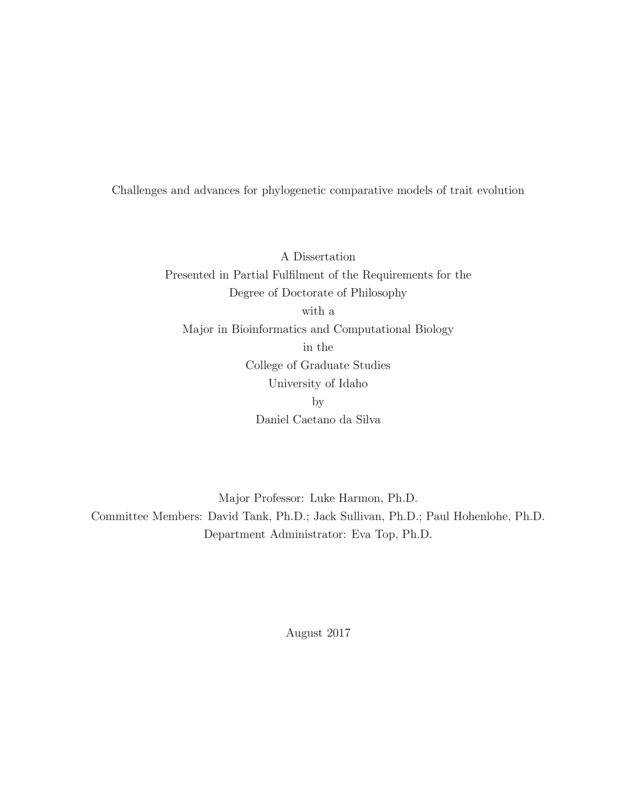Challenges and advances for phylogenetic comparative models of trait evolution
Caetano da Silva, Daniel. (2007). Challenges and advances for phylogenetic comparative models of trait evolution. Theses and Dissertations Collection, University of Idaho Library Digital Collections. https://www.lib.uidaho.edu/digital/etd/items/caetanodasilva_idaho_0089e_11090.html
- Title:
- Challenges and advances for phylogenetic comparative models of trait evolution
- Author:
- Caetano da Silva, Daniel
- Date:
- 2007
- Keywords:
- comparative method evolutionary correlation macroevolution modularity phylogeny trait evolution
- Program:
- Bioinformatics & Computational Biology
- Subject Category:
- Evolution & development; Biology; Systematic biology
- Abstract:
-
A phylogenetic tree is a hypothesis of evolutionary relationships among lineages. The branching pattern of such tree tells us the history of species groups derived from their most recent common ancestors. The length of each branch of this tree represent time, a critical information to study evolutionary processes. Such a tree is the starting point for phylogenetic comparative studies, which aim is to use phylogenies to test hypotheses about macroevolution. One of the most interesting questions on macroevolution is how morphological traits evolved and gave origin to the impressive biodiversity we see today. In this dissertation, I use and develop statistical models to ask questions such as the association between morphological differentiation and lineage diversification and patterns of evolutionary correlation among several traits. The present dissertation is divided into four chapters. The first tests whether the coloration pattern associated with Neotropical false-coral snakes of the family Dipsadidae has a positive effect on the rates of diversification of the group. In the second chapter I focused on evolutionary modularity and developed a novel Bayesian approach to study patters of evolutionary correlation among several continuous traits using Markov-chain Monte Carlo. The third chapter is composed by the implementation of the new method described on Chapter 2 as an R package named ratematrix. In this same chapter, I developed and implemented an extension of Felsenstein's pruning algorithm applied when multiple independent multivariate Brownian-motion rate regimes are fitted to the same phylogenetic tree. The fourth chapter introduces the use of mathematical functions to describe the heterogeneity in the rate of evolution of a continuous trait across the branches of a phylogeny as predicted by a different (also continuous) trait. In summary, in this dissertation I visit different topics associated with phylogenetic comparative models of trait evolution. Each chapter focus on a current challenge in phylogenetic comparative studies; the association of trait with rates of diversification on chapter one, simultaneous study of several traits on chapters two and three and the correlation between rates of evolution and a potential predictor trait on chapter four.
- Description:
- doctoral, Ph.D., Bioinformatics & Computational Biology -- University of Idaho - College of Graduate Studies, 2007
- Major Professor:
- Harmon, Luke J
- Committee:
- Tank, David C; Sullivan, Jack M; Hohenlohe, Paul
- Defense Date:
- 2007
- Identifier:
- CaetanodaSilva_idaho_0089E_11090
- Type:
- Text
- Format Original:
- Format:
- application/pdf
- Rights:
- In Copyright - Educational Use Permitted. For more information, please contact University of Idaho Library Special Collections and Archives Department at libspec@uidaho.edu.
- Standardized Rights:
- http://rightsstatements.org/vocab/InC-EDU/1.0/

